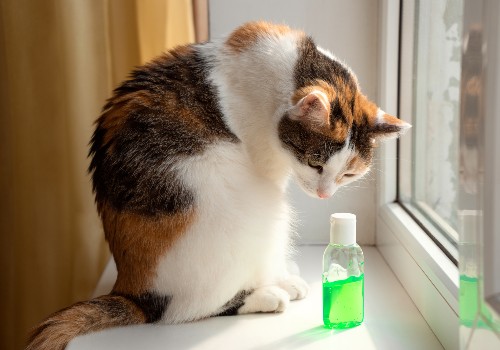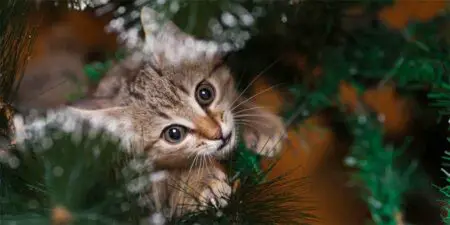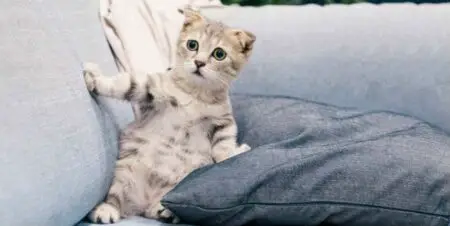Maybe you’re adopting your first cat, or perhaps you and your cat have just moved to a new home. Either way, you’ll need to cat-proof your house to make it a safe, comfortable environment for your kitty.
As with childproofing, cat-proofing is no small task, but it’s absolutely essential. So many everyday household objects, from plants to power cords, can be dangerous or even deadly to cats.
Follow our cat-proofing checklist to keep your home free of feline hazards!
The Cat-Proofing Checklist: Six Ways to Keep Your Home Safe for Kitties!

1. Check Your Doors and Windows
Cats love looking outside — it’s just a fact. And if you have a sliding glass door or big picture window, you can bet that your cat will be spending a lot of time in front of it!
But improperly secured windows and doors can be highly dangerous for cats.
Make sure that all windows, especially ones you plan to open, have screens to prevent your cat from falling out or escaping. The same goes for doors — a screen door creates an “airlock” of sorts to stop your cat from bolting outside.
If your doors or windows have blinds with looped cords, either tie them up or cut the cord into two strands. Cats may think the cord is a toy and jump up, only to get stuck in the loop and potentially suffocate.
2. Hide or Cover Electrical Cords
Many a teething kitten has spotted a chewable-looking power cord and taken a painful bite. And adult cats seem to periodically forget that they should never chew on power cords!
Electrocution is no joke, so keep those tempting power cords out of your cat’s reach. Unplug any devices you don’t regularly use and keep them stored safely away from your cat.
If you have power cords running along your floor or wall, conceal and secure them with cord covers. These covers are usually made of tough rubber or plastic and keep your cords in place while protecting them from sharp kitty teeth.
3. Make Sure Your Plants Are Non-Toxic

Houseplants add a touch of beauty and nature to your home, but many popular varieties are highly toxic to cats. In some cases, all it takes is a little bite out of a leaf for your cat to become violently ill.
Research each of your houseplants to confirm that they’re not toxic to cats. Common toxic houseplants include lilies, aloe vera, monstera, pothos, snake plants and jade plants.
It’s best to keep these plants out of your home altogether. Putting them out of your cat’s reach may be mostly effective, but if a leaf falls or your cat climbs up to them, they could still spell trouble.
4. Keep Your Cupboards and Appliances Closed
You pretty much never want your cat in your cupboards — they’re full of dishes, food and cleaning supplies, none of which he needs access to. So keep them closed to keep him from breaking your dishes or poisoning himself with household chemicals.
You may wish to install self-closing hinges on your cupboard doors so they’re never left open by accident. And if your cat is crafty enough to paw them open himself, childproof cabinet locks may be in order.
It’s also important to keep the doors on your washer, dryer and dishwasher closed. If you leave them open, your cat may decide to curl up inside one for a nap, and you may not realize it before you shut the door and turn it on.
5. Use Essential Oils, Candles and Room Fragrance Carefully
Everyone wants their home to smell nice, but our pleasant perfumes can be off-putting or actively harmful to cats. Tea tree, ylang ylang, citrus, peppermint, eucalyptus and cinnamon oils are all toxic to felines, especially if ingested.
Before spraying that new air freshener or dropping that new essential oil into your diffuser, look it up and make sure it’s safe for cats.
And if you use scented candles — or any candles, really — always keep them out of your cat’s reach. Better yet, use flameless candles for the same atmospheric effects without the danger.
6. Cover Your Garbage, Recycling and Compost
Your cat’s curiosity knows no bounds, so it’s your responsibility to limit his access to nasty temptations like the garbage can and compost bin. Covering your waste receptacles will keep your cat out of them — and trap the nasty sights and smells inside.
Cats can get sick from eating compost or garbage, and they can injure themselves on glass or sharp plastic in recycling bins. Inedible garbage, like dental floss or bread ties, can cause intestinal obstructions if ingested, requiring veterinary attention.
"In ancient times cats were worshipped as gods; they have not forgotten this."
-- Terry Pratchett





